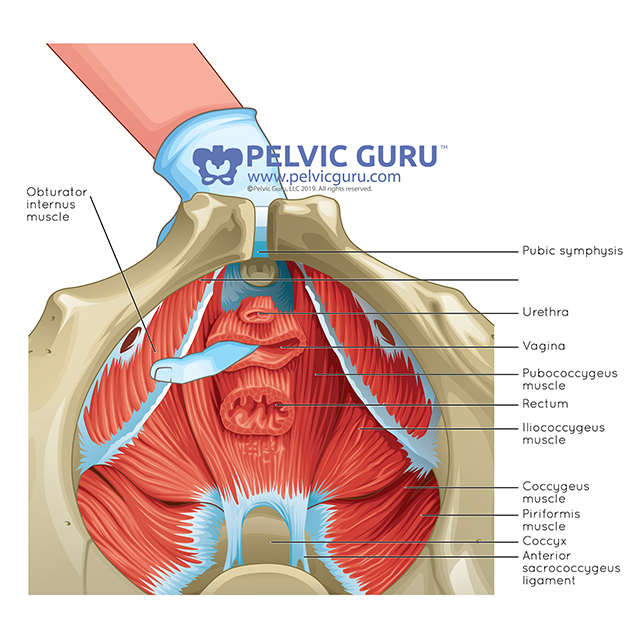A hypertonic pelvic floor has many causes, as it is a pretty common condition, it doesn’t mean it’s not incredibly bothersome, and in some cases, it can be painful.
The definition of a Hypertonic pelvic floor is having a tight muscle tone and reduced capacity of the muscle to stretch. Think of it like a stress ball, you know there are some that are tighter and more difficult to stretch, a hypertonic pelvic floor muscle feels like the muscles being like that tough stress ball, and it shouldn’t really be like it!
Continence.org.au defines it as: “A hypertonic pelvic floor occurs when the muscles in the pelvic floor become too tense and are unable to relax. Many people with a tense and non-relaxing pelvic floor experience pelvic health concerns such as constipation, painful sex, urgency and pelvic pain. A hypertonic pelvic floor may also be accompanied by tension in surrounding hip and pelvic muscles such as the piriformis, obturator internus, coccygeus and hamstrings.”
Having contracted, tense and weakened pelvic floor muscles is not good, as it comes along with restricted blood flow and the oxygenation to the muscle is reduced. This particular condition is not simply diagnosed, as it has many different causes, from different areas of the body.
What can cause a Hypertonic Pelvic Floor?

Here are the causes for Hypertonic Pelvic floor:
- Gynecological: Endometriosis, Fibroids, PCOD, Pelvic Inflammatory Disease, Pregnancy
- Genitourinary: Interstitial Cystitis, Cystocele, Prostatitis, Sexually Transmitted Disease
- Gastrological: Irritable Bowel Syndrome, Chrons Dz, Ulcerative Colitis
- Colorectal: Hemorrhoids, Anal Fissure, Proctalgia Fugax, Hx Colectomy
- Neurological: Pudendal Neuralgia, Migraines, HSV, Shingles, MS
- Rheumatic: Ankylosing Spondylitis, Fibromyalgia, Connective Tissue Disorder with Hypermobility
- Musculoskeletal: Labral Tear Hip, Lumbar Radiculopathy Coccyx Injury
There is also a psychological aspect to it, as anxiety, trauma, and stress can be often felt as tightening of muscles. The variety is so large that the best thing you can do is consult with a Pelvic PT who will help you determine if this is what you experience, and determine a case by case treatment plan for you.
Symptoms of a Hypertonic Pelvic Floor

There is a huge variety of symptoms that can be associated with a Hyperyonic Pelvic Floor, it can be a combination of a few, or just one, either way, if something feels amiss feel free to reach out to your healthcare professional, or book an appointment with a Pelvic PT!
Here is a list of symptoms:
- Constipation
- Incomplete Emptying Of The Bowels
- Straining When Emptying The Bowels
- Pelvic Pain
- Low Back Pain
- Hip Pain
- Coccyx Pain
- Painful Sex
- Vaginismus
- Urinary Incontinence
- Incomplete Emptying Of The Bladder
- Slow Flow Of Urine
- Hesitancy Or Delayed Start Of Urine Stream
- Urinary Urgency
- Urinary Frequency, And
- Painful Urination.
So, if you are experiencing any of these symptoms, try to track what they feel like, when they rise up, and bring this information to your healthcare professional of choice, so they have a better idea of what might be causing this.
3 Exercises for hypertonic pelvic floor!
These are 3 exercises I recommend to my patients, and I have used myself, and gotten incredible results with them, it’s important to take your time with them, and breathe correctly while doing them, so the pelvic floor gets a chance to fully relax.
- Butterfly – to aim for your adductors
- Squat- to aim for decreasing the tone of your pelvic floor muscles
- Childs pose- opens adductor and glut muscles
Breathing Techniques for Hypertonic Pelvic Floor
These can be done at home, and are incredibly helpful when done right! If you have any questions let me know down in the comments!
- Diaphragmatic breathing
- 360° breathing
- Alternate nostril breathing
What is the use of intravaginal dilator/wand therapy for pelvic pain?

Another treatment I often do with patients with a hypertonic pelvic floor, as well as pelvic pain is using a intravaginal dilator/wand! I have recommended many patients this type of therapy, and sometimes I get questions like that, I sometimes get some push back, but ultimately the reason why I recommend it is because it does work!
It’s perfect for deep pelvic floor pain, which can be caused by having some tension in the pelvic floor, tender points, or trigger points. It can also be caused by chronic clenching of the pelvic floor muscles, or postural habits, like leg crossing or tailbone tucking, these often result in deep pelvic floor tension.
The dilators or wands are there to give the area with tenderness a massage, that accompanied with a multifaceted treatment, will reduce pelvic pain.
These dilators come with two different ends for different purposes, the pointed end is benefitial for the deeper pelvic floor muscles or levator ani muscles, these are the muscles that support the pelvic organs such as the rectum, uterus and bladder, and a shorter but rounded end that’s perfect for the muscles near the entrance of the vagina and to address tender points in the rectum!
If you have any questions, feel free to reach out, and I’ll do my very best to help you out!


Recent Comments